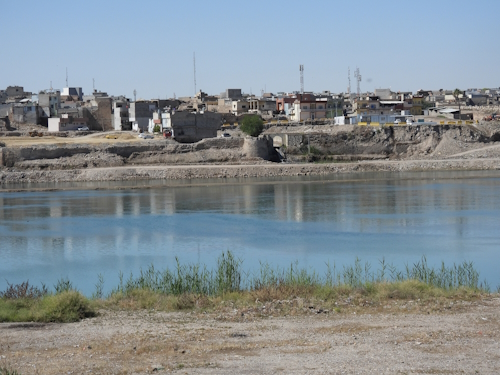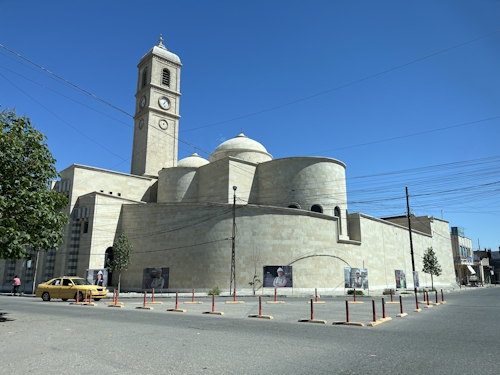Blog TWHS Visits
Old City of Mosul
The northern city of Mosul is the odd one out among the Iraqi (T)WHS. On the one hand, it is probably the one most severely damaged during the recent conflicts (though nearby Nimrud has been hit hard as well). On the other hand, it is the only one that has been subject to a full-scale international rescue mission, which has also brought in internationally accepted restoration and conservation standards.
The Old City of Mosul stands for a thus far unrepresented part of Iraqi history: that of the Turkic-Mongol invasions (though a nomination will also include its Ottoman remains). The Turkic Zengid Dynasty ruled the area of northern Iraq and Syria from Mosul from 1127–1222. The city, located along the major trade routes of the time, was known for its metal craftsmanship and miniature painting. The main monument left from this period is/was the Al-Nouri mosque and its leaning minaret.
Unfortunately, it was exactly this mosque that was blown up by ISIS during their retreat from Mosul. Their black flag had been flying from the minaret since Abu Bakr al-Baghdadi claimed the Caliphate from here in 2014. After losing the Battle of Mosul in April 2017, they blew it up with explosives in a “final act of angry defiance”.
The first impression of the Old Town in April 2025 is still one of devastation (photo 1). The area along the West Bank of the Tigris is in total ruins and part of it has already been bulldozed. The narrow alleyways of the Old Town had been used to fight a guerrilla-style war during the Battle of Mosul. This is where the Ottoman-era quarter is – probably more so in layout than authenticity of the buildings, as most looked not that old to me (plenty of concrete). All standing buildings have been cleared of explosives, but there seems to be no fixed plan for what to do with them.
The Al-Nouri mosque lies a few blocks more “inland” in the core of the city and it was its main mosque. The mosque complex is still fenced off like a construction site, but we were allowed to enter after registering our names on a list with site security. The minaret has now been fully restored, in all its former leaning glory, “like a man bowing”. It’s also impressively tall. The local community had been polled on whether to rebuild the minaret as it was, or leave it in ruins to remember what happened; 94% of the population wanted the monument as it was before. They’re still working on the mosque itself – the interior of the building (which wasn’t as “authentic” as the minaret anyway, as it had been rebuilt many times) still needs a lot, though the massive marble columns are of interest. They’ve also stumbled upon older versions of the mosque underneath and will make those findings visible as well.
Another notable aspect of Mosul has always been the co-existence of different cultural groups. There are several churches in the city center, of different denominations. Like the Al-Nouri mosque, the Notre-Dame de l’Heure convent and the Tahera Church are part of the ‘Revive the Spirit of Mosul’-project. Kick-started with a donation of 50 million USD by the UAE in 2018 and a further 48 million USD by the EU, UNESCO, Iraq's culture ministry, and ICCROM work together in restoring these monuments. The Dominican Notre-Dame de l’Heure convent looks as good as new (photo 3) and work on the Tahera Church has just been completed as well (we weren’t allowed to enter that one as the priest was afraid we would stain the carpets before the upcoming grand opening). The Dominican convent is quite impressive, with stained glass windows and a rooftop from where you’ll get good city views. Religious activity is only occasional – there are hardly any Christians left in Mosul city, although there are more in villages in the surrounding Nineveh Governorate. The Revival Project also tries to revitalize a small heritage quarter with a museum and some Ottoman mansions.
Before I read up on it, I hadn’t been aware how big the ‘Revive the Spirit of Mosul’-project is in a UNESCO context – it is said to be the largest initiative carried by UNESCO since the Abu Simbel move in the 1960s. Funding has reached 115 million USD. So, good news for Mosul, and they may even have it listed as a WHS in a couple of years. But the cynic in me wonders about whether the Shia-dominated parts of Iraq aren’t worthy of foreign investments either. Mosul is a purely Sunni city, which probably explains why the UAE were so quick to throw money at it. The EU has listed anti-terrorism and the coexistence of different religions as two of the main reasons to support the project so generously – it provides lots of local jobs and gives the place its pride back.
Els - 27 April 2025


